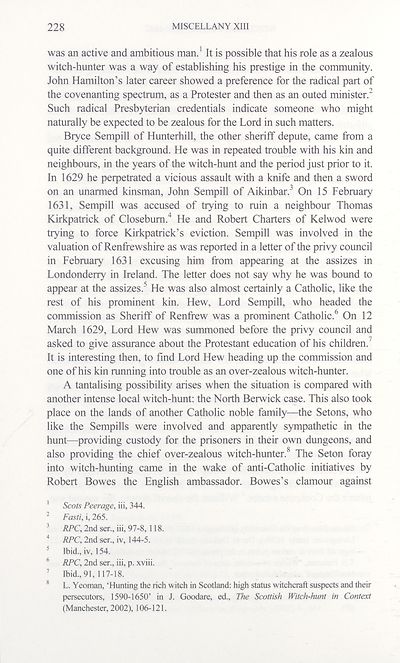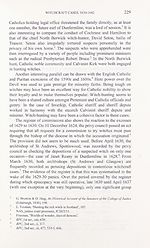Series 5 > Miscellany [of the Scottish History Society] XIII
(243) Page 228
Download files
Complete book:
Individual page:
Thumbnail gallery: Grid view | List view

228
MISCELLANY XIII
was an active and ambitious man.1 It is possible that his role as a zealous
witch-hunter was a way of establishing his prestige in the community.
John Hamilton’s later career showed a preference for the radical part of
the covenanting spectrum, as a Protester and then as an outed minister.2
Such radical Presbyterian credentials indicate someone who might
naturally be expected to be zealous for the Lord in such matters.
Bryce Sempill of Hunterhill, the other sheriff depute, came from a
quite different background. He was in repeated trouble with his kin and
neighbours, in the years of the witch-hunt and the period just prior to it.
In 1629 he perpetrated a vicious assault with a knife and then a sword
on an unarmed kinsman, John Sempill of Aikinbar.3 On 15 February
1631, Sempill was accused of trying to ruin a neighbour Thomas
Kirkpatrick of Closebum.4 He and Robert Charters of Kelwod were
trying to force Kirkpatrick’s eviction. Sempill was involved in the
valuation of Renfrewshire as was reported in a letter of the privy council
in February 1631 excusing him from appearing at the assizes in
Londonderry in Ireland. The letter does not say why he was bound to
appear at the assizes.5 He was also almost certainly a Catholic, like the
rest of his prominent kin. Hew, Lord Sempill, who headed the
commission as Sheriff of Renfrew was a prominent Catholic.6 On 12
March 1629, Lord Hew was summoned before the privy council and
asked to give assurance about the Protestant education of his children.7
It is interesting then, to find Lord Hew heading up the commission and
one of his kin running into trouble as an over-zealous witch-hunter.
A tantalising possibility arises when the situation is compared with
another intense local witch-hunt: the North Berwick case. This also took
place on the lands of another Catholic noble family—the Setons, who
like the Sempills were involved and apparently sympathetic in the
hunt—^providing custody for the prisoners in their own dungeons, and
also providing the chief over-zealous witch-hunter.8 The Seton foray
into witch-hunting came in the wake of anti-Catholic initiatives by
Robert Bowes the English ambassador. Bowes’s clamour against
1 Scots Peerage, iii, 344.
2 Fasti, i, 265.
3 RPC, 2nd sen, iii, 97-8,118.
4 RPC, 2nd sen, iv, 144-5.
5 Ibid., iv, 154.
6 RPC, 2nd ser., iii, p. xviii.
7 Ibid., 91,117-18.
8 L. Yeoman, ‘Hunting the rich witch in Scotland: high status witchcraft suspects and their
persecutors, 1590-1650’ in J. Goodare, ed.. The Scottish Witch-hunt in Context
(Manchester, 2002), 106-121.
MISCELLANY XIII
was an active and ambitious man.1 It is possible that his role as a zealous
witch-hunter was a way of establishing his prestige in the community.
John Hamilton’s later career showed a preference for the radical part of
the covenanting spectrum, as a Protester and then as an outed minister.2
Such radical Presbyterian credentials indicate someone who might
naturally be expected to be zealous for the Lord in such matters.
Bryce Sempill of Hunterhill, the other sheriff depute, came from a
quite different background. He was in repeated trouble with his kin and
neighbours, in the years of the witch-hunt and the period just prior to it.
In 1629 he perpetrated a vicious assault with a knife and then a sword
on an unarmed kinsman, John Sempill of Aikinbar.3 On 15 February
1631, Sempill was accused of trying to ruin a neighbour Thomas
Kirkpatrick of Closebum.4 He and Robert Charters of Kelwod were
trying to force Kirkpatrick’s eviction. Sempill was involved in the
valuation of Renfrewshire as was reported in a letter of the privy council
in February 1631 excusing him from appearing at the assizes in
Londonderry in Ireland. The letter does not say why he was bound to
appear at the assizes.5 He was also almost certainly a Catholic, like the
rest of his prominent kin. Hew, Lord Sempill, who headed the
commission as Sheriff of Renfrew was a prominent Catholic.6 On 12
March 1629, Lord Hew was summoned before the privy council and
asked to give assurance about the Protestant education of his children.7
It is interesting then, to find Lord Hew heading up the commission and
one of his kin running into trouble as an over-zealous witch-hunter.
A tantalising possibility arises when the situation is compared with
another intense local witch-hunt: the North Berwick case. This also took
place on the lands of another Catholic noble family—the Setons, who
like the Sempills were involved and apparently sympathetic in the
hunt—^providing custody for the prisoners in their own dungeons, and
also providing the chief over-zealous witch-hunter.8 The Seton foray
into witch-hunting came in the wake of anti-Catholic initiatives by
Robert Bowes the English ambassador. Bowes’s clamour against
1 Scots Peerage, iii, 344.
2 Fasti, i, 265.
3 RPC, 2nd sen, iii, 97-8,118.
4 RPC, 2nd sen, iv, 144-5.
5 Ibid., iv, 154.
6 RPC, 2nd ser., iii, p. xviii.
7 Ibid., 91,117-18.
8 L. Yeoman, ‘Hunting the rich witch in Scotland: high status witchcraft suspects and their
persecutors, 1590-1650’ in J. Goodare, ed.. The Scottish Witch-hunt in Context
(Manchester, 2002), 106-121.
Set display mode to:
![]() Universal Viewer |
Universal Viewer | ![]() Mirador |
Large image | Transcription
Mirador |
Large image | Transcription
Images and transcriptions on this page, including medium image downloads, may be used under the Creative Commons Attribution 4.0 International Licence unless otherwise stated. ![]()
| Scottish History Society volumes > Series 5 > Miscellany [of the Scottish History Society] XIII > (243) Page 228 |
|---|
| Permanent URL | https://digital.nls.uk/127316445 |
|---|
| Description | Over 180 volumes, published by the Scottish History Society, containing original sources on Scotland's history and people. With a wide range of subjects, the books collectively cover all periods from the 12th to 20th centuries, and reflect changing trends in Scottish history. Sources are accompanied by scholarly interpretation, references and bibliographies. Volumes are usually published annually, and more digitised volumes will be added as they become available. |
|---|


